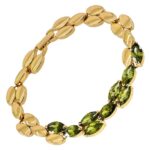The world of handmade jewelry sales is a lucrative industry that offers the opportunity for financial independence and creative expression. With the demand for unique and handcrafted jewelry on the rise, there has never been a better time to explore this profitable market. In this article, we will guide you through the process of making money by selling handmade jewelry-from identifying your unique style to perfecting your techniques, building your brand, pricing strategies, and effective selling channels.
As more consumers search for one-of-a-kind pieces that reflect their individuality, the demand for handmade jewelry continues to grow. The appeal lies in the ability to offer customers something truly unique and personal, crafted with love and attention to detail. By tapping into this market, you have the potential to turn your passion for creating jewelry into a profitable business venture.
Not only does selling handmade jewelry provide an avenue for financial success, but it also offers a space for artistic expression and fulfillment. With creativity at the forefront, you have the freedom to experiment with different designs and materials, allowing your imagination to run wild. By following the steps outlined in this article, you can transform your creative vision into reality while developing a sustainable business model in the process.
Unleashing Your Creativity
When it comes to selling handmade jewelry, one of the most important factors in attracting customers and standing out from the competition is developing a unique jewelry style. In this section, we will explore how you can unleash your creativity to identify and refine your own distinct jewelry style that reflects your artistic capabilities and personal preferences.
Discovering Your Artistic Capabilities
The first step in identifying your unique jewelry style is to discover your artistic capabilities. Take the time to experiment with different materials, techniques, and designs. Consider taking classes or workshops to learn new skills and expand your creativity. The more you practice and explore different artistic avenues, the better you will understand what resonates with you and what sets you apart from others.
It’s also important to pay attention to your personal preferences and aesthetic sensibilities. What colors, textures, or patterns do you find yourself drawn to? Think about what inspires you – nature, architecture, cultures – and incorporate those influences into your creations. By embracing your artistic capabilities and personal tastes, you can create jewelry pieces that truly reflect who you are as an artist.
Crafting Jewelry Pieces That Stand Out
In a saturated market where consumers have countless options for jewelry purchases, it’s crucial to create pieces that stand out from the crowd. Start by researching current trends in the handmade jewelry industry while staying true to your own creative vision. Look for techniques or materials that are popular among consumers but put your unique spin on them.
Consider experimenting with unconventional materials or incorporating unexpected elements into your designs. Combining different materials like gemstones, metals, beads or wood can create stunning pieces that catch customers’ attention. Additionally, incorporating uncommon shapes or unusual design elements can make your creations truly memorable.
Remember that developing a unique jewelry style is an ongoing process. Keep refining and evolving it as you gain more experience and feedback from customers. By continually pushing the boundaries of your creativity and staying true to your artistic vision, you will establish a distinctive brand identity that attracts loyal customers year after year.
Sourcing High-Quality Materials
Sourcing high-quality materials is a crucial factor in the success of your handmade jewelry business. Using top-notch materials not only ensures that your products are durable and long-lasting but also adds value and appeal to your creations. Here are some tips for sourcing high-quality materials without compromising on affordability:
- Research and Identify Reliable Suppliers: Take the time to research and identify reliable suppliers who offer high-quality materials. Look for suppliers with a good reputation, positive customer reviews, and a wide range of options for different types of jewelry components such as beads, gemstones, chains, clasps, and findings. Online marketplaces like Etsy, Alibaba, and eBay can be great sources for finding reputable suppliers.
- Assess Material Quality: Before making any purchases, thoroughly assess the quality of the materials you are considering. Look for signs of durability such as sturdy construction, resistance to tarnishing or fading, and genuine certification for gemstones or precious metals if applicable. If possible, request samples or small quantities to personally evaluate the materials before buying in bulk.
- Compare Prices: While it’s important to prioritize quality, it’s also necessary to find affordable sources for your materials. Compare prices from different suppliers to ensure you are getting the best deal without compromising on quality. Keep in mind that cheaper options may sacrifice quality, so strike a balance between price and value.
- Seek Out Local Resources: Consider exploring local resources such as jewelry supply stores or gem shows in your area. These can provide opportunities to see and feel the materials firsthand before purchasing them. Additionally, building relationships with local suppliers may lead to potential discounts or exclusive access to unique materials.
- Establish Relationships with Suppliers: Once you have identified reliable suppliers, establish strong relationships with them by providing regular business and maintaining open communication channels. This can help secure better deals or priority access to newly released materials.
By sourcing high-quality materials for your handmade jewelry creations, you not only enhance the value and attractiveness of your products but also build a reputation for craftsmanship and quality that can attract loyal customers. Remember to continuously assess and improve your material sources to stay ahead of evolving trends and customer demands.
Perfecting Your Techniques
Mastering the art of handmade jewelry requires a dedication to continuous practice and the refinement of techniques. This section will explore the importance of honing your skills and provide guidance on specific techniques and trends that can increase customer appeal.
The Importance of Continuous Practice
Becoming skilled in creating handmade jewelry takes time and effort. It is essential to dedicate yourself to continuous practice in order to improve your craftsmanship. Find time each day or week to work on your creations, experimenting with different designs and techniques. By consistently practicing, you will develop muscle memory and increase your efficiency in crafting pieces.
Additionally, it is important to seek feedback from others in order to grow as an artist. Join online communities or local artisan groups where you can share your work and receive constructive criticism. Taking workshops or classes related to jewelry making can also be beneficial as they provide an opportunity to learn new techniques from experienced artists.
Specific Techniques and Trends
To stand out in the competitive market of handmade jewelry, it is crucial to stay up-to-date with current trends while maintaining your unique style. Experiment with different materials, textures, colors, and styles to create fresh and innovative designs that capture customers’ attention.
One trend that continues to gain popularity is personalized jewelry. Customers love pieces that are tailored specifically for them or their loved ones. Consider offering custom-made options such as initial necklaces, birthstone bracelets, or engraved rings. This allows customers to feel connected to the piece on a deeper level and increases the chances of repeat sales.
Another technique to explore is incorporating unconventional materials into your designs. For example, using recycled materials like old keys, bottle caps, or fabric scraps can add a unique touch to your creations while promoting sustainability.
By continuously refining your techniques and staying aware of trends, you can ensure that your handmade jewelry stands out from the crowd and appeals to a wide range of customers.
Building Your Brand
In a saturated market, building a strong brand is essential to stand out from your competitors and attract customers to your handmade jewelry business. Your brand identity and mission statement will help create a unique and recognizable image that aligns with the values and aesthetic of your jewelry. Utilizing social media, websites, and other marketing platforms can also showcase your creations to a wider audience.
Defining your brand identity starts with understanding what sets you apart from others in the industry. Take time to evaluate your style, craftsmanship, and overall vision for your jewelry business. Identify key elements that make your pieces distinctive, whether it’s working with unconventional materials or using innovative techniques.
Once you have a clear idea of your brand identity, translate it into an effective online presence. Social media platforms like Instagram and Pinterest are popular among jewelry enthusiasts, providing visual mediums to showcase your pieces. Make sure to consistently post high-quality images that reflect the unique aesthetic of your brand.
Additionally, having a website is crucial for establishing credibility and showcasing the breadth of your collection. It’s important to invest in professional product photography that accurately represents the quality of your jewelry. Consider including sections on your website that tell the story behind each piece or provide insights into your creative process – this adds value to the customer experience.
To further strengthen your brand, consider collaborating with influencers or partnering with complementary businesses in the fashion or accessories industry. By associating yourself with reputable individuals or brands, you can expand your reach and gain credibility within the market.
| Key Points | Details |
|---|---|
| Understand Your Unique Selling Proposition (USP) | – Evaluate what makes your jewelry stand out
|
| Utilize Social Media | – Use platforms like Instagram and Pinterest
|
| Create a Professional Website | – Invest in professional product photography
|
| Collaborate with Influencers and Complementary Brands | – Associate yourself with reputable individuals or brands
|
Pricing Strategies
Determining the worth of your handmade jewelry is a crucial element in running a successful business. Pricing your products appropriately ensures profitability while maintaining competitiveness in the market. In this section, we will explore effective pricing strategies that you can implement to optimize your sales.
When it comes to determining the price of your handmade jewelry, it is important to consider the cost of materials, labor, and overhead expenses. Start by calculating the total cost of materials used for each piece. This includes beads, gemstones, findings, and any other components you incorporate into your designs. Keep track of these costs and update them regularly as prices may fluctuate.
Next, factor in the time and effort spent on crafting each piece. Consider how long it takes to create a single item, including design development, assembly, polishing, and finishing touches. Decide on an hourly wage for yourself or determine an average time spent per piece so that you can calculate labor costs accurately.
In addition to material and labor costs, don’t forget about your overhead expenses such as packaging materials, tools and equipment maintenance, marketing expenses, website fees if applicable, and any other relevant costs. It is important to allocate a portion of these expenses into each piece to ensure you are covering all aspects of your business operations.
Once you have determined the total cost for each handmade jewelry piece, it’s time to set your price. There are a few different methods you can use:
- Cost-Plus Pricing: This method involves adding a markup percentage to cover both costs and desired profit margin. For example, if the total cost of materials plus labor is $30 and you want a 50% profit margin ($15), then multiply $30 by 1 + 0.5 = $45.
- Market-Based Pricing: This strategy involves researching similar products in the market and setting your price based on what customers are willing to pay for comparable items. Analyze prices from competitors with similar quality and style, and adjust accordingly.
- Value-Based Pricing: This approach considers the perceived value of your handmade jewelry in the eyes of your target customers. Factors such as uniqueness, craftsmanship, and brand reputation can justify a higher price point.
Remember that pricing is not a one-time decision. Regularly reassess and adjust your prices based on changes in costs, demand, trends, or any other relevant factors. Striking a balance between profitability and competitiveness is essential for long-term success in the handmade jewelry industry.
Effective Selling Channels
Selling handmade jewelry requires more than just creating beautiful pieces; it also involves finding the right channels to generate sales and engage with customers. In this section, we will explore some effective selling channels that can help you reach a wider audience and increase your chances of success.
One popular option for selling handmade jewelry is through online marketplaces such as Etsy and Shopify. These platforms provide a ready-made customer base and allow you to showcase your products to a global audience. With millions of users visiting these sites every day, it’s important to optimize your listings with high-quality product photos, detailed descriptions, and competitive pricing. Building a strong online presence through these platforms can significantly boost your sales and customer engagement.
In addition to online marketplaces, consider organizing or participating in craft fairs, pop-up shops, and other local events. These events not only give you an opportunity to showcase your creations in person but also allow you to connect with potential customers on a personal level.
Make sure to create an eye-catching booth display that showcases the uniqueness of your jewelry and highlights your brand identity. Engaging with customers directly at these events can build trust, generate immediate sales, and even lead to long-term relationships.
Combining both online and offline selling channels can maximize your chances of success in selling handmade jewelry. It’s important to remember that each channel requires its own strategy and approach. By utilizing multiple channels effectively, you can cast a wider net, reach more customers, and ultimately increase sales.
| Selling Channels | Benefits |
|---|---|
| Online marketplaces (Etsy, Shopify) | – Access to a large customer base
|
| Craft fairs and local events | – Personal connection with customers
|
Building Customer Loyalty
Building customer loyalty is a crucial aspect of running a successful handmade jewelry business. While attracting new customers is important, it is equally essential to retain and nurture existing customers in order to generate repeat sales. This section will explore strategies for building customer loyalty and generating positive reviews.
Exceptional customer service is the cornerstone of building customer loyalty. Providing a personalized experience and going above and beyond to meet your customers’ needs will leave a lasting impression. Responding promptly to inquiries, offering assistance with customization or repairs, and showing genuine appreciation for their support are all ways to make your customers feel valued.
One effective strategy for nurturing customer loyalty is to establish a rewards program. By offering incentives or discounts to repeat customers, you create an incentive for them to continue purchasing from you. This can be as simple as offering exclusive discounts or freebies after a certain number of purchases or creating a tiered system where customers unlock special benefits based on their level of engagement.
Another important aspect of building customer loyalty is fostering engagement through effective communication channels. Regularly engage with your customers through social media platforms, email newsletters, or even handwritten thank-you notes accompanying their purchases. Building a relationship with your customers beyond the transactional exchange will keep them engaged and more likely to make repeat purchases.
Positive reviews are invaluable in building trust and credibility among potential customers. Encourage satisfied customers to leave reviews on your website or relevant review platforms by offering incentives such as discounts on future purchases. Additionally, showcasing testimonials or featuring customer stories on your website can help build trust and encourage potential buyers to choose your jewelry over competitors’.
By focusing on building customer loyalty through exceptional service, rewards programs, meaningful communication, and positive reviews, you can create a loyal customer base that not only keeps coming back for more but also spreads the word about your handmade jewelry business. Ultimately, these loyal customers become brand ambassadors who play an instrumental role in the growth of your business through word-of-mouth recommendations and referrals.
Expansion and Scaling Up
Once your handmade jewelry business starts to gain traction and generate consistent sales, you may find yourself considering expansion and scaling up your operations. Scaling your business involves increasing production, expanding your reach, and exploring new opportunities for growth. Here are some factors to consider as you navigate this exciting phase of your journey.
One important aspect to consider when scaling up your handmade jewelry business is the need for additional help or partnerships. As demand increases, you may find that it becomes harder to manage all aspects of the business on your own. Assess your workload and determine if it’s time to hire employees or partner with others who can bring their expertise to the table. Look for individuals who share your passion for jewelry making and align with your brand values.
Collaborations, wholesale opportunities, and retail partnerships are also avenues to explore when scaling up. Collaborating with other artisans or designers can lead to innovative designs that attract a wider customer base. Wholesale opportunities allow you to sell larger quantities of jewelry at lower prices to retailers who will then distribute them to consumers.
This can boost both exposure and revenue for your business. Retail partnerships involve partnering with brick-and-mortar stores or online boutiques that would carry and promote your jewelry alongside other complementary products.
As you expand, it’s crucial to maintain the quality and uniqueness that sets your handmade jewelry apart from mass-produced alternatives. Pay attention to quality control processes and ensure that they remain consistent even as production volume increases. Stay true to the aesthetic style that has resonated with customers so far while also keeping an eye on emerging trends in the market.
Scaling a handmade jewelry business requires careful planning, organization, and adaptation. Keep a close eye on inventory management systems as well as financial records so that you have a clear understanding of profitability as you grow. Regularly review pricing strategies and adjust them if necessary, taking into account changes in material costs or production expenses.
Scaling your handmade jewelry business can be an exciting and challenging endeavor. By carefully considering the right timing, seeking additional help or partnerships, exploring new opportunities, and maintaining quality, you can successfully grow your business while remaining true to your artistic vision and customer base. With perseverance and adaptability, the potential for success and profitability is within your reach.
Conclusion
In conclusion, the journey to profitable handmade jewelry sales is an empowering and fulfilling endeavor. By following the steps outlined in this article, you have equipped yourself with the knowledge and resources to thrive in this industry. Your ability to unleash your creativity, source high-quality materials, perfect your techniques, build a brand, implement effective pricing strategies, find effective selling channels, build customer loyalty, and consider opportunities for expansion have positioned you for success.
As you embark on this journey, it is essential to reflect on the steps you have taken and celebrate the progress you have made. Starting a handmade jewelry business requires dedication, perseverance, and a willingness to adapt to market trends and customer preferences. By embracing these qualities and continuously refining your skills and offerings, you have set yourself apart from competitors.
It is important to remember that success may not come overnight. Building a profitable handmade jewelry business takes time and effort. There will be challenges along the way, but these obstacles should not deter you. Instead, view them as valuable learning experiences that will contribute to your growth as an entrepreneur.
As you continue your journey in the world of handmade jewelry sales, maintain a positive attitude and enjoy the satisfaction that comes from running a successful business. Embrace new opportunities for growth through collaborations, wholesale opportunities, and retail partnerships.
With perseverance and adaptability as your allies, there is no limit to what you can achieve in this lucrative industry. So keep dreaming big and continue crafting beautiful pieces that bring joy to your customers’ lives while also bringing prosperity into yours.
Frequently Asked Questions
Is it profitable to make handmade jewelry?
Making handmade jewelry can be profitable, but it largely depends on various factors such as the quality and uniqueness of the pieces, target market, pricing strategy, and marketing efforts. Handmade jewelry has the advantage of offering a level of craftsmanship and individuality that mass-produced items typically lack.
By focusing on creating high-quality designs that stand out, utilizing unique materials, and appealing to a niche market or specific customer needs, artisans can often command higher prices and achieve profitability. Additionally, by selling directly to customers through platforms like online stores or craft fairs, it is possible to eliminate middlemen and retain a larger portion of the profits.
Does homemade jewelry sell well?
Homemade jewelry can indeed sell well if it meets the preferences and demands of potential buyers. It is important for artisans to identify their target audience and create designs that resonate with their tastes. Utilizing social media platforms and online marketplaces specifically catered to handmade products can also significantly increase exposure to potential customers.
Building a strong brand reputation for quality craftsmanship, customer service, and unique designs will help attract buyers looking for something special or personalized. However,{comma} some may face challenges due to competition from mass-produced jewelry brands with lower price points or more established reputations.
How much can you sell handmade jewelry for?
The selling price of handmade jewelry can vary greatly depending on factors such as materials used, complexity of design, brand reputation,{delete{ perceived value built through marketing efforts{delete}, competition in the market,{” “lowercase{T}}ARGET{” “uppercase{M}}ARKET{” “}demographics,{” “}and geographical location.
Generally,{comma} it is advisable for artisans to calculate their costs accurately by considering not only material costs but also labor time invested in crafting each piece{period} This ensures that they cover expenses while generating profit margin{s}\{period} Determining an adequate retail price involves researching similar handmade jewelry items in the market{s},{ }considering buyer expectations related to quality and exclusivity,{ }and assessing the perceived value of the products{period} Depending on these factors,{ }prices for handmade jewelry may range from relatively affordable pieces in {dollar}10 to {dollar}30 price range{comma} to more high-end designs that can reach hundreds or even thousands of dollars{period}

Welcome to my jewelry blog! My name is Sarah and I am the owner of this blog.
I love making jewelry and sharing my creations with others.
So whether you’re someone who loves wearing jewelry yourself or simply enjoys learning about it, be sure to check out my blog for insightful posts on everything related to this exciting topic!





